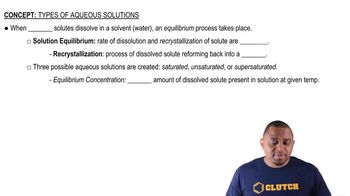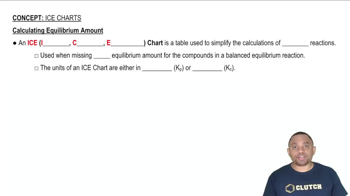At 80°C, 𝐾𝑐 = 1.87×10−3 for the reaction PH3BCl3(𝑠) ⇌ PH3(𝑔) + BCl3(𝑔) (a) Calculate the equilibrium concentrations of PH3 and BCl3 if a solid sample of PH3BCl3 is placed in a closed vessel at 80°C and decomposes until equilibrium is reached.
Ch.15 - Chemical Equilibrium
Chapter 15, Problem 58
At 25°C, the reaction CaCrO4(𝑠) ⇌ Ca2+(𝑎𝑞) + CrO42−(𝑎𝑞) has an equilibrium constant 𝐾𝑐 = 7.1×10−4. What are the equilibrium concentrations of Ca2+ and CrO42− in a saturated solution of CaCrO4?
 Verified step by step guidance
Verified step by step guidance1
Identify the reaction and write the equilibrium expression. For the dissolution of CaCrO4, the reaction is: CaCrO4(s) ⇌ Ca2+(aq) + CrO42−(aq). The equilibrium expression is Kc = [Ca2+][CrO42−].
Set up an ICE table (Initial, Change, Equilibrium) to track the concentrations of the ions. Initially, the concentrations of Ca2+ and CrO42− are 0. Let x be the change in concentration of Ca2+ and CrO42− as CaCrO4 dissolves.
At equilibrium, the concentrations of Ca2+ and CrO42− will both be x. Substitute these values into the equilibrium expression: Kc = x * x = x^2.
Solve for x by taking the square root of both sides of the equation Kc = x^2. This gives x = sqrt(Kc).
Substitute the value of Kc (7.1×10−4) into the equation for x to find the equilibrium concentrations of Ca2+ and CrO42−.

Verified video answer for a similar problem:
This video solution was recommended by our tutors as helpful for the problem above.
Video duration:
2mWas this helpful?
Key Concepts
Here are the essential concepts you must grasp in order to answer the question correctly.
Equilibrium Constant (Kc)
The equilibrium constant (Kc) is a numerical value that expresses the ratio of the concentrations of products to reactants at equilibrium for a given reaction at a specific temperature. For the reaction CaCrO₄(s) ⇌ Ca²⁺(aq) + CrO₄²⁻(aq), Kc indicates how far the reaction favors the formation of products. A small Kc value, like 7.1×10⁻⁴, suggests that at equilibrium, the concentration of reactants is much higher than that of products.
Recommended video:
Guided course

Equilibrium Constant Expressions
Saturated Solution
A saturated solution is a solution that contains the maximum concentration of a solute that can dissolve at a given temperature and pressure. In the context of the reaction, a saturated solution of CaCrO₄ means that the solution has reached a point where no more CaCrO₄ can dissolve, and the concentrations of Ca²⁺ and CrO₄²⁻ ions are at their equilibrium values, determined by the Kc of the reaction.
Recommended video:
Guided course

Types of Aqueous Solutions
ICE Table (Initial, Change, Equilibrium)
An ICE table is a tool used to organize the initial concentrations, changes in concentrations, and equilibrium concentrations of reactants and products in a chemical reaction. For the given reaction, the ICE table helps to set up the relationship between the initial concentration of CaCrO₄, the changes in concentrations of Ca²⁺ and CrO₄²⁻ as the system reaches equilibrium, and ultimately allows for the calculation of their equilibrium concentrations using the Kc value.
Recommended video:
Guided course

ICE Charts and Equilibrium Amount
Related Practice
Textbook Question
Textbook Question
At 80°C, 𝐾𝑐 = 1.87×10−3 for the reaction PH3BCl3(𝑠) ⇌ PH3(𝑔) + BCl3(𝑔) (a) Calculate the equilibrium concentrations of PH3 and BCl3 if a solid sample of PH3BCl3 is placed in a closed vessel at 80°C and decomposes until equilibrium is reached. (b) If the flask has a volume of 0.250 L, what is the minimum mass of PH3BCl3(𝑠) that must be added to the flask to achieve equilibrium?
Textbook Question
Consider the following equilibrium, for which Δ𝐻<0
2 SO2(𝑔) + O2(𝑔) ⇌ 2 SO3(𝑔)
(e) the total pressure of the system is increased by adding a noble gas
Textbook Question
Consider the following equilibrium, for which Δ𝐻<0
2 SO2(𝑔) + O2(𝑔) ⇌ 2 SO3(𝑔)
(f) How will each of the following changes affect an equilibrium mixture of the three gases: SO3(𝑔) is removed from the system?
